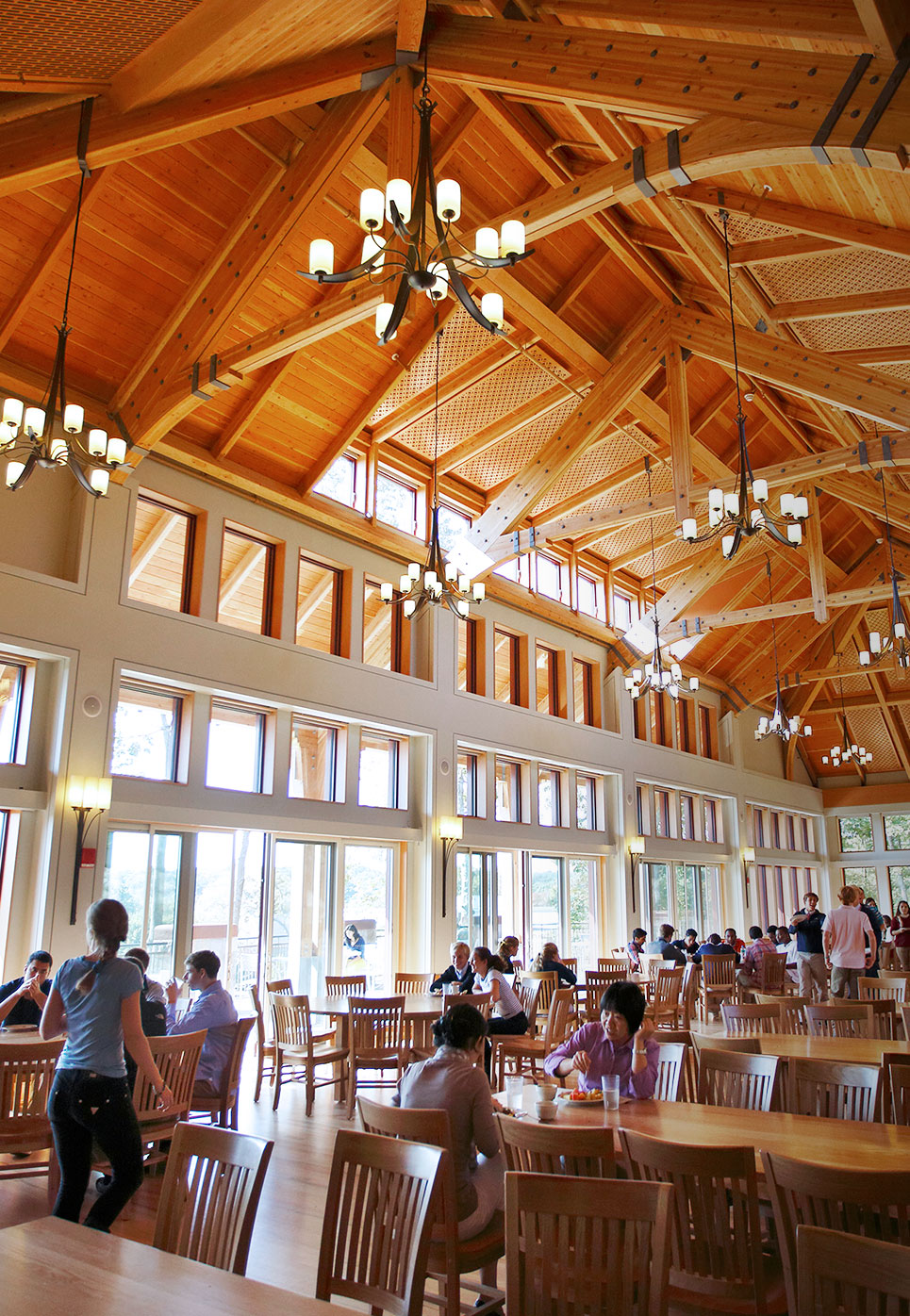The Noble and Greenough School Policy on Transgender, Non-binary and Gender Non-conforming Individuals
Noble and Greenough School believes that the inclusion of dynamic voices can only enhance the rigor and excellence of our school. Excellence in education and social development requires a diverse, inclusive community with a growth mindset. Tantamount to that is striving to create a space that is safe, welcoming, and that celebrates all genders and gender identities. Nobles recognizes that there are a plethora of gender identities including but not limited to transgender, non-binary, gender non-conforming, genderqueer, cisgender, demigender and more. For the purposes of this document,Transgender, Non-binary and Gender Non-conforming is meant to be an umbrella term to include all gender identities with the exception of cisgender.
The school strives to foster an environment that is inclusive, equitable and free of discrimination for all people regardless of assigned sex, gender identity or gender expression. The school accepts the gender identity that each individual asserts. Community members are able to access spaces and programs in a manner that is consistent with their gender identity, and processes will be in place to ensure safe integration. Ongoing training and education of all stakeholders (including but not limited to employees, students and parents/guardians) are essential to our work to reduce the stigmatization and facilitate the integration of transgender, non-binary and gender non-conforming individuals in the Nobles community. The school will maintain the privacy of all individuals and their families. School staff shall not disclose any information that may reveal information about a student’s gender identity to others unless legally required to do so or unless the student has authorized such disclosure. Definitions These definitions are provided not for the purpose of labeling students but rather to assist in understanding the terminology within this policy. Individuals may or may not use these terms to describe themselves. Gender identity: the internal sense of one’s own gender (someone’s sex assigned at birth and their gender identity are not necessarily the same) Gender: Gender is a social construct that refers to how one relates to the gender categories within one’s society. These are often described with values such as masculinity, femininity, or androgyny, and usually involve one’s behaviors, attitudes, and appearance/expression. Commonly, gender is assigned at birth, based on one’s sex, and one is typically raised with the expectation that one will identify as that given gender. Gender can align with one’s sex (cisgender) or differ from one’s sex (transgender). Transgender (often shortened to trans): someone who does not identify as the sex they were assigned at birth (commonly used to refer to men who were assigned female at birth (trans men), and women who were assigned male at birth (trans women), these examples being known as binary trans people; some non-binary people identify as trans because their gender is not what was assigned to them at birth while others choose not to identify as trans) Cisgender (often shortened to cis): someone who identifies with the sex they were assigned at birth Assigned sex: the sex (male, female, intersex, etc.) one is assigned at birth, often based on physical anatomy, DNA, and chromosomes Intersex: someone who is born with reproductive or sexual anatomy that doesn’t fit the typical definitions of female or male Genderfluid: someone whose gender identity changes over time (a genderfluid person can identify as any gender or combination of genders at any given time) Demigender: someone who feels a partial, but not full, connection to a particular gender identity Neutrois: a non-binary gender identity that is associated with having a neutral or null gender Trigender: someone who has three distinct gender identities (these three gender identities can be any gender, and trigender people may experience these genders simultaneously or fluidly) Bigender: someone who has two distinct gender identities (these two gender identities can be any gender, and bigender people may experience these genders simultaneously or fluidly) Non-binary (sometimes shortened to nb or enby) someone whose gender does not fall strictly within the category of binary genders (male or female); anyone who is not always 100% male or always 100% female may consider themselves non-binary. Agender: someone who is agender may have an undefined gender, feel as if they don’t identify with any particular gender, have a neutral gender, or decide not to label their gender (this term can mean different things to different people, so it’s not limited to the examples listed above) Genderqueer: someone who feels that they have a queer or non-normative experience with gender, either through their gender identity, their gender presentation, or other experiences of gender Pangender: someone who experiences/identifies with all genders Polygender: someone who experiences/identifies with two or more genders Genderflux: someone whose perception of their gender (or how much they identify with the gender) fluctuates in intensity Gender Expression: How one expresses one or more of their genders. Usually expressed through behavior, clothing, haircut or voice, and which may or may not conform to socially defined behaviors and characteristics typically associated with being either masculine or feminine. This does not always align with a person’s gender identity and/or assigned sex. Femme: an identity or presentation that leans towards femininity. femme can be an adjective (he’s a femme boy), a verb (she feels better when she “femmes up”), or a noun (they’re a femme). although commonly associated with feminine lesbian/queer women, it’s used by many to describe a distinct gender identity and/or expression, and does not necessarily imply that one also identifies as a woman or not. Boi: a term used within queer communities of color to refer to sexual orientation, gender, and/or aesthetic among people assigned female at birth. boi often designates queer women who present with masculinity (although, this depends on location and usage). This term originated in women of color communities. Butch: an identity or presentation that leans towards masculinity. butch can be an adjective (she’s a butch woman), a verb (he went home to “butch up”), or a noun (they identify as a butch). although commonly associated with masculine queer/lesbian women, it’s used by many to describe a distinct gender identity and/or expression, and does not necessarily imply that one also identifies as a woman or not. Related Terms: Pronouns: words that can be used in place of a noun or a noun phrase.T he most well known example of pronouns are personal pronouns, which can refer to the person or people speaking (first person), the person or people being spoken to (second person), or other people or things (third person). In many Indo-European languages, including English, third person personal pronouns can be gendered. Widely used pronouns are they/them, she/her and he/him. Pronouns do not necessarily correlate with one’s gender identity. ie. someone who is non-binary can use he/him pronouns. Neopronouns: any set of singular third-person pronouns typically created with the intent of being a gender neutral pronoun set (e.g. xe/xem, ze/zir, ey/em, fae/faer) This policy will support healthy communication between educators, parents/guardians and students to further the successful educational development and well-being of every member of the community. This policy covers, but is not limited to, conduct that takes place on school property (both physical and virtual) and at all school-sponsored functions and activities. This policy also pertains to usage of electronic communication. This policy applies to all members of the school community, including, but not limited to, students, employees, parents/guardians, volunteers and guests. In compliance with state and federal law, Nobles shall accept the gender identity that each individual asserts. There is no medical or treatment threshold that individuals must meet in order to have their gender identity recognized and respected by all members of the community. Nobles recognizes that the needs of individuals , ranging from identity questioning to assertion, will be unique to their particular circumstances. Therefore, to support individuals who seek support and guidance from the school, we will balance all relevant factors including, but not limited to, the individual’s preference, protecting privacy, maximizing social integration, minimizing stigmatization, the individual’s safety, and available facilities on campus. Any individual who needs assistance with this policy, including addressing concerns about student records, school facilities and other activities, should contact the dean of students, dean of diversity and inclusion, director of human resources, the appropriate class dean, the student’s advisor, school counselors, or another trusted adult in the community. Every individual has the right to be addressed by the name and pronouns that they feel most comfortable with. A court-ordered name or gender change is not required, and the student need not change their official records. While inadvertent slips or honest mistakes in the use of names or pronouns may occur, the school will not tolerate intentional and persistent refusal to respect an individual’s gender identity by using the wrong name and/or pronouns. If necessary, the school will maintain student records that include a student’s legal name and sex assigned at birth. To the extent that the school is not legally required to use a student’s legal name and assigned sex on other school records or documents, the school shall use the name and gender preferred by the student. This may include, but is not limited to, letters of recommendation, diploma, student schedules, disciplinary records, etc. For documents that require a legal name, including transcripts, the legal name on file will be used. The school will change a student’s official record to reflect a change in legal name or gender upon receipt of documentation that such change has been made pursuant to a court order, or through amendment of state or federally issued identification. The school is sensitive to the private nature of discussions and documentation regarding a student’s name and/or gender and is committed to protecting the student’s confidentiality by restricting the use of, and access to, this information in accordance with applicable law. The school is also sensitive to the role parents/guardians play in this matter and will work closely with families to ensure that they receive the support they may need. All persons, including students, have a right to privacy, and this includes the right to keep one’s gender identity private at school. Information about a student’s gender identity, legal name, or gender assigned at birth constitutes confidential personally identifiable and medical information. Disclosing this information to other students or parents or other third parties may violate privacy laws, such as the federal Family Educational Rights and Privacy Act (FERPA), as well as constitutional privacy protections. Additionally, disclosure or misuse of this information may establish a hostile environment for a transgender or gender nonconforming student, potentially subjecting them to bullying and harassment, by peers, discrimination by school staff, or family rejection. Under Massachusetts state law, information about a student’s assigned sex, name change for gender identity purposes, gender transition, medical or mental health treatment related to gender identity, or any other information of a similar nature, regardless of its form, is part of the individual’s student record is confidential, and must be kept private and secure, except in limited circumstances. One circumstance is when authorized school personnel require the information to provide administrative, teaching, counseling, or other services to the student in the performance of their official duties. For transgender students, authorized school personnel could include individuals such as the principal, school nurse, classroom teacher(s), or guidance or adjustment counselor. When a student new to a school is using a chosen name, the birth name is considered private information and may be disclosed only with authorization from the student and their family. If the student has previously been known at school or in school records by their birth name, the principal should direct school personnel to use the student’s chosen name. Every effort should be made to update student records with the student’s chosen name and not circulate records with the student’s assigned birth name. Records with the student’s assigned birth name should be kept in a separate, confidential file. When determining which, if any, staff should be informed that a student’s gender identity is different from the assigned birth sex, decisions should be made in consultation with the student, or in the case of a young student, the student’s parent or guardian. The key question is whether and how sharing the information will benefit the student. In the rare instance that a school is legally required to disclose a student’s gender identity, the school should provide the student an opportunity to make that disclosure themselves, where practicable. This would include providing the student with any support services the student would need to make the disclosure in a safe and supportive environment. Transgender and gender nonconforming students may decide to discuss and express their gender identity openly and may decide when, with whom, and how much to share private information. A student who is 14 years of age or older, or who has entered the ninth grade, may consent to disclosure of information from their student record. If a student is under 14 and is not yet in the ninth grade, the student’s parent (alone) has the authority to decide on disclosures and other student record matters. The following gender neutral bathrooms are available on campus: Shattuck Schoolhouse: 2nd Floor between Shattuck 200 and 205 Under no circumstances may students be required to use single sex facilities that are inconsistent with their gender identity. The school may maintain separate restrooms, locker rooms or changing facilities, to which individuals are allowed access based on their gender identity. In any single sex facility, any individual who is uncomfortable using a shared facility, regardless of the reason, shall, upon the individual’s request, be provided with a reasonable alternative. This may include, for example, addition of a privacy partition or curtain, provision to use a nearby private restroom or office, or a separate changing schedule. Requiring a transgender or gender non-conforming student to use a separate, non-integrated space threatens to publicly identify and marginalize the student as transgender, and should not be done unless requested by a student. The dean of students, the appropriate class dean, and the student’s advisor will meet with students making specific requests to review appropriate adjustments as they apply to restrooms and changing facilities on campus. Transgender, non-binary, and gender non-conforming students are permitted to participate on single-sex teams, productions, and groups in a manner consistent with their gender identity or of their choosing if no such team exists, to the extent that their participation complies with this policy and the athletic competition rules and bylaws of the New England Prep School Athletic Council and the Independent School League. In each case, school staff will ascertain student needs and evaluate the best process to support each student’s success. Individuals are permitted to dress in accordance with their gender identity and gender expression, within the constraints of the dress code adopted by the school. School staff shall not enforce a school’s dress code more strictly against transgender and gender non-conforming students than other students. The school will evaluate all gender-based activities, rules, policies and practices on an ongoing basis and maintain only those that have a clear and sound pedagogical purpose. Individuals shall be permitted to participate in any such activities or conform to any such rule, policy or practice consistent with their gender identity. The school will conduct training for all employees on their responsibilities under applicable laws and this policy. Information regarding this policy shall be incorporated into training for new school employees as part of the new employee orientation. The school will implement mandatory ongoing professional development to build the skills of all employees to prevent, identify and respond to bullying, harassment and discrimination. The content of such professional development shall include, but not be limited to: (i) inviting experts on gender identity to campus to discuss language, concepts and current developmental understandings of gender identity, gender expression and gender diversity in children and adolescents; (ii) developmentally appropriate strategies for communication with students and parents/guardians about issues related to gender identity and gender expression that protect student privacy; (iii) developmentally appropriate strategies for preventing and intervening in incidents of harassment. This guidance cannot anticipate every situation in which questions may come up in the implementation of this policy, and the needs of each transgender or gender non-conforming individual should be assessed and addressed on a case-by-case basis. The school will continue to provide assistance, support and resources as we work together to create a safe and supportive environment for all individuals.Principles
Education
Policy
Names and Pronouns
Official Records
Privacy
Access to Space
Henderson Arts Center: the Green Room/theater offices
Pratt Middle School: Nurse’s office
Baker Science Building: 1st floor next to faculty offices 109 and 110
Castle: One in basement near elevator and one on 1st floor, near coffee station
Lawson House: All bathrooms
Academic Center: One next to 120 and one next to the elevator and 108
Morrison Athletic Center: Private changing rooms and bathrooms are located across from the fitness center in the visiting team locker roomsAccess to Athletic Teams and Performing Arts Groups and Productions
Dress Code
Other Gender-Based Activities, Rules, Policies and Practices
Community Training and Procedure
Conclusion
Sources: GLSEN’s Model Trans Policy, Rivers School Transgender Policy, Mass. Anti-Discrimination Law, Mass. State Guidance for Public Schools, LGBTQ Wiki




